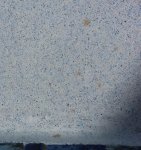So I had the plaster (diamond brite) redone a few months back as part of the pool remodel and now I'm finding a few light brown patches here and there. There are a couple on the steps of the pool and a few in the deep end. They absolutely do not brush away with vigorous brushing from the diamond brite metal/nylon brush. I also tried rubbing one of the spots on the steps with a chlorine puck last night and it did not seem to have any effect. Then I tried rubbing the spot with a vitamin c tab (thinking it was iron) and that also had no effect whatsoever.
Prior to having the diamond brite done, the pool had a few of these exact sorts of spots already which is what makes me think it is a chemical and not an algae. The pool has always been crystal clear since we bought the house almost a year ago. I've never had even the slightest green tint to the water. I added borax to the pool last night and, against my better judgement, I've got some polyquat 60 to add to the pool tomorrow in the event that this is some sort of algae growing which I think is unlikely. Chlorine is at 4 ppm currently but I often let it get low without ill effect. Ph always climbs, probably b/c of the new plaster and a small suction side air leak that I think I've finally fixed... but i try to stay on top of it and don't let it get crazy or anything like that (maybe up to 8 or so). CH, according to the pool store (I have a basic test kit), is at 380. CYA is at 30ppm.
So if the vit C tabs and chlorine pucks don't seem to do anything, what could it be? It's light brown in color and the spots are maybe the size of a penny and about that color. I don't think it's "rebar pop" and there are no other metal objects in the pool. I filled the pool with municipal water in South FL which does not seem to be high in iron - no rust stains in my toilets or on my house from the sprinklers. Thoughts?
Prior to having the diamond brite done, the pool had a few of these exact sorts of spots already which is what makes me think it is a chemical and not an algae. The pool has always been crystal clear since we bought the house almost a year ago. I've never had even the slightest green tint to the water. I added borax to the pool last night and, against my better judgement, I've got some polyquat 60 to add to the pool tomorrow in the event that this is some sort of algae growing which I think is unlikely. Chlorine is at 4 ppm currently but I often let it get low without ill effect. Ph always climbs, probably b/c of the new plaster and a small suction side air leak that I think I've finally fixed... but i try to stay on top of it and don't let it get crazy or anything like that (maybe up to 8 or so). CH, according to the pool store (I have a basic test kit), is at 380. CYA is at 30ppm.
So if the vit C tabs and chlorine pucks don't seem to do anything, what could it be? It's light brown in color and the spots are maybe the size of a penny and about that color. I don't think it's "rebar pop" and there are no other metal objects in the pool. I filled the pool with municipal water in South FL which does not seem to be high in iron - no rust stains in my toilets or on my house from the sprinklers. Thoughts?


